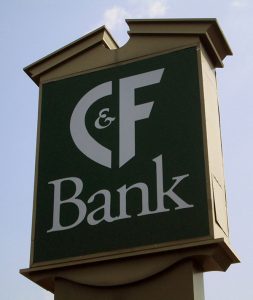
C&F Bank’s sign at its branch on West Broad Street.
Having struggled to fully recover after the recession, a local bank is finally in the arms of its white knight.
Central Virginia Bankshares on Tuesday completed a deal to be acquired by C&F Financial Corp., parent of C&F Bank.
The deal brings Powhatan-based CVB and its Central Virginia Bank subsidiary under the larger and more stable C&F umbrella. C&F in turn adds CVB’s deposit base, employees and seven branches, giving it a stronger presence in the southwestern part of the Richmond market.
C&F, which now has $1.4 billion in total assets, paid $855,000 in cash or $0.32 per share to acquire CVB. The West Point-based company also paid $3.35 million to buy CVB out of the TARP Capital Purchase Program.
CVB’s stock symbol “CVBK” was retired effective Oct. 1. But for now, the CVB brand remains.
C&F chief executive Larry Dillon, who will oversee the combined companies, said the company would look to phase out the CVB bank brand. A formal merger of the two bank subsidiaries, including separate regulatory approval, would be required for that maneuver. It also has the task of merging both banks’ front- and back-office systems.
“We still have an awful lot of work ahead of us,” Dillon said.
The deal was announced June 10, a day after Union First Market Bank and StellarOne Bank announced a plan to merge. The companies got the green light for the deal in late September as regulators and shareholders of both firms approved the acquisition.
A $387 million bank, CVB ran into trouble with big losses between 2008 and 2010 due to failed investments in Lehman Brothers, Fannie Mae and Freddie Mac. It was then hit by rising levels of soured commercial real estate and business loans as the real estate market turned.
“There were some mistakes made [at CVB],” Dillon said. “But looking back, everything is 20/20, and we could have easily made some of the mistakes they did going into this recession.”

Herb Marth
Veteran banker Herb Marth was brought in at CVB in 2010 as a turnaround specialist. He was named permanent president and chief executive in January 2011, replacing longtime chief Larry Lyons.
As a result of Tuesday’s deal, Marth will become a senior banking executive within C&F and will become a member of C&F Bank’s Richmond board.
Jim Napier, a local realtor who has been chairman of CVB’s board, gets a seat on the C&F board of directors.
An important piece of the acquisition was getting the right price on CVB’s TARP shares, Dillon said.
The U.S. Treasury allowed C&F to buy back preferred shares and common stock at a steep discount. CVB received $11.4 million through the program and hasn’t had the cash or the ability to raise capital to buy its way out. It was also hindered by a written agreement that prevented it from paying dividends of any kind, including on TARP.
“[Treasury] agreed to take a substantial discount on what they invested in CVB,” Dillon said. “That was the only way it could have worked.”
With the addition of CVB’s workforce, C&F now has about 600 employees, Dillon said. CVB’s ranks were already pretty thin, and it’s working to merge all the workers into roles at the combined companies, he said.

C&F Bank’s sign at its branch on West Broad Street.
Having struggled to fully recover after the recession, a local bank is finally in the arms of its white knight.
Central Virginia Bankshares on Tuesday completed a deal to be acquired by C&F Financial Corp., parent of C&F Bank.
The deal brings Powhatan-based CVB and its Central Virginia Bank subsidiary under the larger and more stable C&F umbrella. C&F in turn adds CVB’s deposit base, employees and seven branches, giving it a stronger presence in the southwestern part of the Richmond market.
C&F, which now has $1.4 billion in total assets, paid $855,000 in cash or $0.32 per share to acquire CVB. The West Point-based company also paid $3.35 million to buy CVB out of the TARP Capital Purchase Program.
CVB’s stock symbol “CVBK” was retired effective Oct. 1. But for now, the CVB brand remains.
C&F chief executive Larry Dillon, who will oversee the combined companies, said the company would look to phase out the CVB bank brand. A formal merger of the two bank subsidiaries, including separate regulatory approval, would be required for that maneuver. It also has the task of merging both banks’ front- and back-office systems.
“We still have an awful lot of work ahead of us,” Dillon said.
The deal was announced June 10, a day after Union First Market Bank and StellarOne Bank announced a plan to merge. The companies got the green light for the deal in late September as regulators and shareholders of both firms approved the acquisition.
A $387 million bank, CVB ran into trouble with big losses between 2008 and 2010 due to failed investments in Lehman Brothers, Fannie Mae and Freddie Mac. It was then hit by rising levels of soured commercial real estate and business loans as the real estate market turned.
“There were some mistakes made [at CVB],” Dillon said. “But looking back, everything is 20/20, and we could have easily made some of the mistakes they did going into this recession.”

Herb Marth
Veteran banker Herb Marth was brought in at CVB in 2010 as a turnaround specialist. He was named permanent president and chief executive in January 2011, replacing longtime chief Larry Lyons.
As a result of Tuesday’s deal, Marth will become a senior banking executive within C&F and will become a member of C&F Bank’s Richmond board.
Jim Napier, a local realtor who has been chairman of CVB’s board, gets a seat on the C&F board of directors.
An important piece of the acquisition was getting the right price on CVB’s TARP shares, Dillon said.
The U.S. Treasury allowed C&F to buy back preferred shares and common stock at a steep discount. CVB received $11.4 million through the program and hasn’t had the cash or the ability to raise capital to buy its way out. It was also hindered by a written agreement that prevented it from paying dividends of any kind, including on TARP.
“[Treasury] agreed to take a substantial discount on what they invested in CVB,” Dillon said. “That was the only way it could have worked.”
With the addition of CVB’s workforce, C&F now has about 600 employees, Dillon said. CVB’s ranks were already pretty thin, and it’s working to merge all the workers into roles at the combined companies, he said.